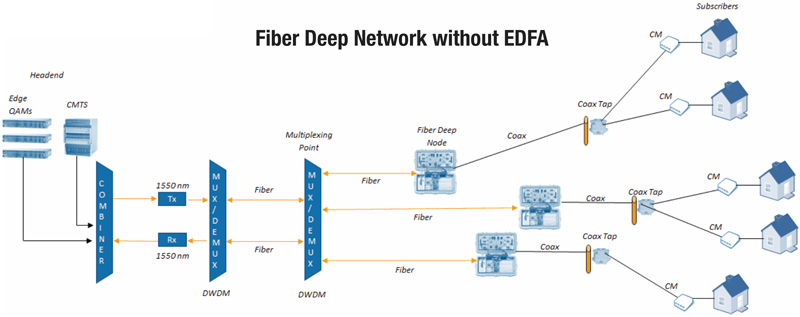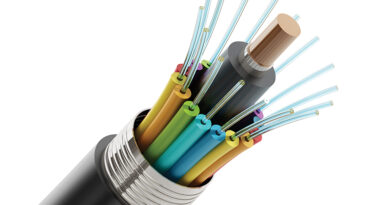Focusing on the Customer Experience with Fiber Deep
By Steven Harris
Our cable subscribers continue to have a thirst for the latest video resolutions, voice reliability, mission critical data and the next generation wireless products and services. As operators continue evolve these products and services, and add new offerings like virtual reality, the access network must follow in parallel to support exponential growth. The network must support smaller subscriber counts, improved reliability and progress the quality of experience for the customer. The access network of the future must support gigabit data rates and beyond, while maintaining the highest levels of performance.
As our current physical access network architectures and design approaches continue to evolve, they must accommodate the introduction of new signal processing and transport technologies. The access network will require the adoption of scalable new standard architectures leveraging new hardware components and designs. One of the scalable architectures is called “fiber deep,” bringing the next evolution and growth to the access network. Fiber deep also simplifies the physical access network setup and alignment, increasing its reliability and performance.
Our cable networks have always been rich in fiber optics, whether we refer to the transport or access network. To date, many operators across the globe have been deploying newer optical approaches such as radio frequency over glass (RFoG), Ethernet passive optical network (EPON) and gigabit passive optical network (GPON) systems deepening their fiber deployments. Another architecture that increases fiber deployment while improving the performance and reliability is fiber deep, also referred to as node + 0. The optical-to-electrical demarcation of the access network signaling in fiber deep occurs much closer to the customer premises while eliminating coaxial active devices.

To fully understand this new architecture, let’s discuss a comparison of fiber deep to traditional HFC. In the HFC access network a physical combination of coaxial and fiber cabling is used to deliver services. Fiber deep is similar to traditional HFC in this sense, as the network will still use both types of cabling. However, fiber deep will not utilize active devices in the last mile network. Trunk amplifiers, bridger amplifiers or line extenders are not required like a traditional HFC access network, creating a near passive design. With the removal of active devices, optical nodes will have a different location in the fiber deep network. Fiber deep nodes may be designed to be within a few hundred or thousand feet from the customer premises.
The delivery of video, voice and data signals from an operator’s headend to the customer premises may be like traditional HFC. However, there may be other features implemented within the fiber deep access network, creating some big changes in signal delivery. One major change that may occur in the system is how the upstream and downstream operate over fiber deep design. During a fiber deep deployment, an operator may change to an RF mid-split design. In a popular RF mid-split design, the upstream signals will operate from 5 MHz to 85 MHz instead of the 5 MHz to 42 MHz used in traditional HFC. In the downstream, additional forward spectrum may be added to support 1002 MHz (1 GHz), with the ability to migrate to 1.218 GHz in the future.
Modifications will be required at the headend or hub for fiber deep, as multiple forward path optical signals will now be required to push fiber deep nodes closer to the customer premises. Multiple optical signals are combined using an optical multiplexer (mux) and dense wavelength division multiplexing (DWDM) technology. The multiplexed optical signals are then transmitted into the fiber deep network until it reaches a multiplexing point, typically in the vicinity of an existing legacy HFC node. At the multiplexing point, the individual DWDM optical signals will be recovered and fed over individual wavelengths to each new fiber deep node. Each wavelength typically will serve a maximum of 128 homes passed, though most operators may opt for lower home passed counts like 64.
In some cases, a forward fiber deep design may require an erbium doped fiber amplifier (EDFA) at the multiplexing point to maintain the correct optical levels for fiber deep nodes. However, operators prefer the use of low input optical receivers at the fiber deep nodes over EDFA deployments. An EDFA requires power, using a multiplexing point near a legacy HFC node provides access to power. In the fiber deep network, the EDFA and/or multiplexing point maybe located in a node-like housing as offered in some virtual type hubs. This node-like housing with an EDFA will be referred to as the “mother node” or “parent node.” From the “mother node” optical signals will be distributed to each of the fiber deep nodes in the network.
At this point in the design, the fiber deep nodes will now perform the traditional optical analog intensity modulation (AIM) to coaxial quadrature amplitude modulation (QAM) conversion. In cases where DOCSIS 3.1 is utilized in the network for HSD coaxial signals, newer multiplexing may exist using orthogonal frequency division multiplexing (OFDM). There are some changes being made to the output levels of the fiber deep node as well. The nodes will be putting out higher transmit levels on the downstream and improved S/N as compared to a traditional HFC plant. This is done in order to compensate for the removal of amplifiers and expansion of the downstream or forward path to 1.218 GHz.
For the return path in fiber deep, individual digitized returns from each fiber deep node are routed via a DWDM wavelength over their own fiber back to the multiplexing point for final transport back to the headend or hub where de-multiplexing occurs prior to routing to individual digital headend return receivers. The fiber deep nodes will be receiving lower input levels as compared to a traditional HFC plant.
The new fiber deep access network provides support for future advanced technologies and platforms, while increasing the velocity of deployment. As mentioned, fiber deep allows for the expansion of the forward and return path bandwidth. Fiber deep utilizing the deployment of modular node platforms and short fiber extensions provides a path to fiber to the premises / home (FTTP/H) architectures such as RFoG and xPON for higher overall capacity and increased service speeds. In the future, fiber deep will allow for the use of digital forward optics and emerging distributed access architecture (DAA) solutions like remote PHY. At SCTE•ISBE you can prepare yourself for the future of cable. Learn more at http://www.scte.org/fttx.
 Steven Harris
Steven Harris
Senior Director, Advanced Network Technology and Instruction, Learning and Development, SCTE/ISBE
Steve Harris is the senior director of advanced network technology and instruction at SCTE/ISBE. He is a respected international telecommunications subject matter expert, sought-after presenter and principle instructor. He is responsible for the tremendous growth of SCTE/ISBE training programs and certifications for over a 100,000 telecommunication professionals. He also has responsibility for the client partnership in the SCTE/ISBE Corporate Alliance Program for MSOs and vendors.
Source: SCTE•ISBE, Shutterstock




